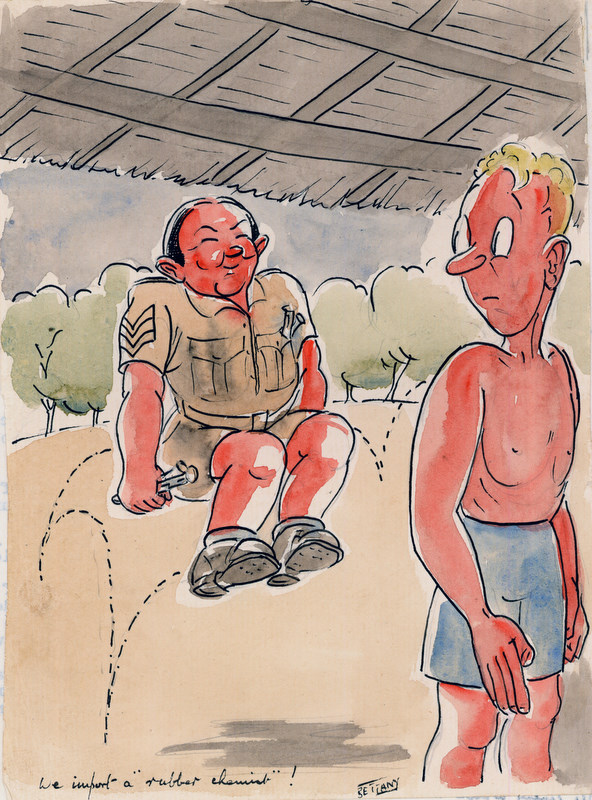We Import a ‘Rubber Chemist’
A research chemist who had worked for the Rubber Research Institute of Malaya, came into camp off a working party. His skills were soon put to use.
This image of Des Bettany’s artwork has been reproduced with permission from the book ‘Don’t Ever Again Say “It Can’t Be Done”’ published by The Changi Museum, Singapore.
‘In the early days of our prisoner of war career… a handful of volunteers got together with a view to repairing shoes … (it) later proved to be the birth of one of the most essential and useful installations in the camp: namely, the Rubber Factory.’
‘On the strength of these experiments it was decided to open a factory for the manufacture of these rubber soles. Tappers, to tap the rubber trees and bring the latex to the factory each morning, were trained. Mixers were trained to mix latex, laterite and cement in their exact quantities.’
Source: Robert Moffett, ‘Rubber Factory Report’, in Lachlan Grant (ed.), The Changi Book, Published by New South in association with the Australian War Memorial, 2015, pg. 200, 203
‘On 31st December 1942, Captain Albert Symonds was sent back to Changi …. where he was appointed to be in charge of the camp workshops.
In a community the size of Changi, as a need arose, someone was found with the knowledge or ability to produce what was required … rubber sandals, rope, nails, the list was endless and it included making coffins.
He continued to run the workshops for the duration of his captivity, at the heart of an enterprise which saw prisoners employing remarkable ingenuity to fashion everyday but, nonetheless, vital objects from the most basic materials.
We acquired barrack room lockers … which we cut, shaped and welded into dixies, mugs, baking trays, buckets and pails. We produced toothbrushes and brooms using the same palm fronds that we used for attap. Clogs were mad from motor tyres and from soft rubber wood, and with the latex from the rubber trees we repaired boots and shoes.
When in 1944, the Japanese gave the order that all prisoners were to move to the confines of Changi jail, the workshops were quickly dismantled and relocated and continued to produce a steady stream of much needed equipment, those in the workshops providing much of the labour and ingenuity which went into making the jail more habitable.’
Source: ‘A Cruel Captivity’ by Ellie Taylor, 2018, page 31& 32, Pen & Sword Books Ltd.

